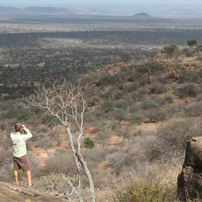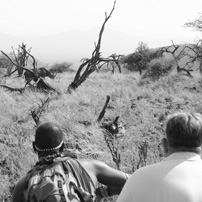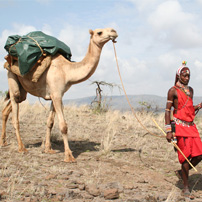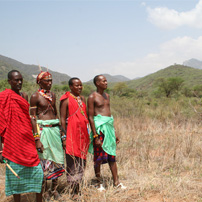‘Elephants, from earlier this morning’ surmised our guide Gabriel, giving the toilet roll shaped lump of digested grass and twigs the obligatory poke with his foot, just as a dung beetle appeared and began its work in earnest. After a few minutes of listening and watching, we moved on carefully to the top of MuKenya Hill, a boulder strewn hill or ‘kopje’ rising from the plains of the Mpala Ranch in Kenya’s western Laikipia. Mukenya reminded me of one of those hills mentioned in a Wilbur Smith novel, insignificant in the grand scheme of things, but the perfect vantage point and hide out for runaway lovers, hunters or explorers.
 It had taken us a couple of hours to reach the top of the hill from our beautiful camp on the Ewaso Nyiro River, and we had seen plenty of game en route, including reticulated giraffe, Burchell’s and Grevy’s zebra, dik dik and impala, as well as a plethora of birds and fresh lion tracks. As we sat on a boulder, sipping our water and admiring the wonderful views, Gabriel, the head guide at Karisia Walking Safaris, spoke quietly ‘here they come’. Looking round we watched in silence as a family herd of five elephants crossed the open saddle between our vantage point and the main peak of MuKenya. It was amazing to find them so high on the mountain, but elephants are surprisingly agile. As they passed in front of us and the wind swirled the matriarch of the herd clearly smelt us, trunks curled into the air, and their relaxed amble changed to a purposeful gait as they moved quickly away down the hill. As we sat in stunned silence at our unexpected encounter, I was aware of a feeling of deep satisfaction. To be on foot in the heart of the African wilderness, with endless views and surrounded by pristine nature – does it get any better?
It had taken us a couple of hours to reach the top of the hill from our beautiful camp on the Ewaso Nyiro River, and we had seen plenty of game en route, including reticulated giraffe, Burchell’s and Grevy’s zebra, dik dik and impala, as well as a plethora of birds and fresh lion tracks. As we sat on a boulder, sipping our water and admiring the wonderful views, Gabriel, the head guide at Karisia Walking Safaris, spoke quietly ‘here they come’. Looking round we watched in silence as a family herd of five elephants crossed the open saddle between our vantage point and the main peak of MuKenya. It was amazing to find them so high on the mountain, but elephants are surprisingly agile. As they passed in front of us and the wind swirled the matriarch of the herd clearly smelt us, trunks curled into the air, and their relaxed amble changed to a purposeful gait as they moved quickly away down the hill. As we sat in stunned silence at our unexpected encounter, I was aware of a feeling of deep satisfaction. To be on foot in the heart of the African wilderness, with endless views and surrounded by pristine nature – does it get any better?
 Three days and several safari lodges later, I was hot on the trail of two black rhino, a mother and calf, in the Lewa Conservancy in the eastern Laikipia region. My guide, the charismatic Kitonga, who leads Lewa Walking Wild, had picked up the subtle signs a while back, and was confident we would find them. Given the time of day (mid-morning, starting to get hot so the rhino would rest up soon) and the freshness of the tracks I had no doubt we would find them, but what impressed me was the way Kitonga involved me in the tracking process. In addition to looking at the spoor, he showed me bushes that had been ‘nibbled’, rocks which had the smallest ‘scuff’ of wet dirt on them, and stones that had been misplaced by their passage. It was a master-class in tracking, delivered in such a relaxed style. Now, if I could just get him to slow up a little…….…with the sun rising higher by the minute, this purposeful Maasai was becoming hard to keep up with! We did get wonderful views of the mother and calf, creeping to about 50 yards away without them ever knowing we were there (perfect, in my books) and also saw a beautiful martial eagle, elephants, Grevy’s zebra, reticulated giraffe and oryx.
Three days and several safari lodges later, I was hot on the trail of two black rhino, a mother and calf, in the Lewa Conservancy in the eastern Laikipia region. My guide, the charismatic Kitonga, who leads Lewa Walking Wild, had picked up the subtle signs a while back, and was confident we would find them. Given the time of day (mid-morning, starting to get hot so the rhino would rest up soon) and the freshness of the tracks I had no doubt we would find them, but what impressed me was the way Kitonga involved me in the tracking process. In addition to looking at the spoor, he showed me bushes that had been ‘nibbled’, rocks which had the smallest ‘scuff’ of wet dirt on them, and stones that had been misplaced by their passage. It was a master-class in tracking, delivered in such a relaxed style. Now, if I could just get him to slow up a little…….…with the sun rising higher by the minute, this purposeful Maasai was becoming hard to keep up with! We did get wonderful views of the mother and calf, creeping to about 50 yards away without them ever knowing we were there (perfect, in my books) and also saw a beautiful martial eagle, elephants, Grevy’s zebra, reticulated giraffe and oryx.
Both of these dedicated walking safaris reminded me just how wild and remote you can be in northern Kenya, without spending hours travelling overland or an arm and a leg in charter flights. I spent 8 days exploring the extensive Laikipia region, Samburu Game Reserve, The Mathews Range and Meru National Park, and all these regions offer something spectacular for the more discerning traveller (please see our Kenya Map for the geography).
 For me, the walking trails really stood out on this trip. We have long been supporters of Kitonga and his Lewa Walking Wild safari, which begins on the Lewa Conservancy and can be undertaken over any number of days, usually 2 to 5 nights. Kitonga is a brilliant guide and for slightly more adventurous guests this safari will always be a superb option. However, having spent some time with Karisia Walking Safaris, I have equal enthusiasm for what they can offer. Run by owners James Christian and Kerry Glen, Karisia can offer a little more sophistication than Lewa Walking Wild. They have a wide range of good walking habitats to explore, and with either Kerry or Jamie available to lead each trip, you are guaranteed an extremely personal hosting experience (this is optional as they offer Samburu-led safaris with Gabriel and his team too).
For me, the walking trails really stood out on this trip. We have long been supporters of Kitonga and his Lewa Walking Wild safari, which begins on the Lewa Conservancy and can be undertaken over any number of days, usually 2 to 5 nights. Kitonga is a brilliant guide and for slightly more adventurous guests this safari will always be a superb option. However, having spent some time with Karisia Walking Safaris, I have equal enthusiasm for what they can offer. Run by owners James Christian and Kerry Glen, Karisia can offer a little more sophistication than Lewa Walking Wild. They have a wide range of good walking habitats to explore, and with either Kerry or Jamie available to lead each trip, you are guaranteed an extremely personal hosting experience (this is optional as they offer Samburu-led safaris with Gabriel and his team too).
 Both these walking trails operate using camels to carry equipment and provisions, with the camels available for you to ride if required. There are a number of other operations in northern Kenya which offer a similar walking adventure, usually as a ‘fly-camping’ safari from their own permanent camp or lodge. However, if you enjoy walking and wilderness but are not so keen on the camping aspect of these multi-day safaris, then walking is widely available as an activity from a number of exclusive properties throughout northern Kenya.
Both these walking trails operate using camels to carry equipment and provisions, with the camels available for you to ride if required. There are a number of other operations in northern Kenya which offer a similar walking adventure, usually as a ‘fly-camping’ safari from their own permanent camp or lodge. However, if you enjoy walking and wilderness but are not so keen on the camping aspect of these multi-day safaris, then walking is widely available as an activity from a number of exclusive properties throughout northern Kenya.
